Overview
At first glance, coyotes may not seem that important. After all, you’ve probably heard quite a bit about these animals being a nuisance, overbreeding, and killing farm animals. But because we know you love animals as much as we do, we want to share the other side of the story.
To do that, we go beyond skimming the surface. Instead, we give you an in-depth view so that you appreciate its importance in the ecosystem.
We describe how this animal lives and its hunting skills, starting with vital information about the coyote’s beginnings, habitat, and behavior. Other aspects include it being deeply protective. We end up with the coyote’s place in folklore and answer some final questions that intrigue readers.
Taxonomy and Evolution
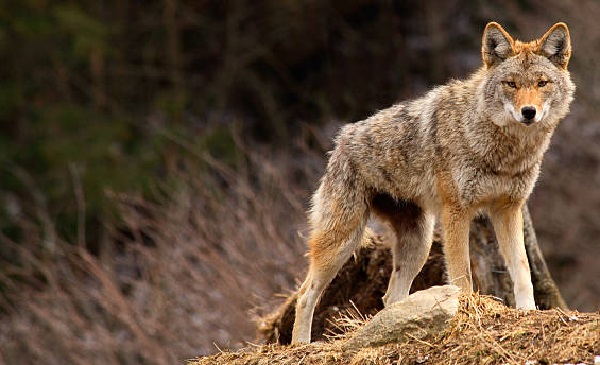
Taxonomy is the classification of living things that consists of seven levels. Scientists use this classification because it makes it easier to study living organisms in respect of their lineage and shared behaviors.
Starting at the bottom rung of taxonomy, prairie wolves belong to the Canis latrans species. This species is part of the Canis genus, which belongs to the Canidae family.
Similarly, this dog family or genus canis is in the Carnivora order in the Mammalia class of animals. In turn, this class belongs to the Chordata phylum in the Animalia kingdom.
In short, coyotes, jackals, grey wolves, and the domestic dog are related and share an original lineage and way of behaving.
Scientists have found coyote fossils dating back about two million years ago in the Gelasian stage of the Pleistocene age. Their studies suggest that this dog evolved from a type of wolf in North America.
Coyote Behavior
If animals fascinate you, you may recognize how the prairie wolf shares many characteristics with domestic dogs. These wild animals also differ from other canine species in some ways.
Here, we focus on their social and reproductive patterns, territorial and sheltering characteristics, and how they hunt, feed, and communicate.
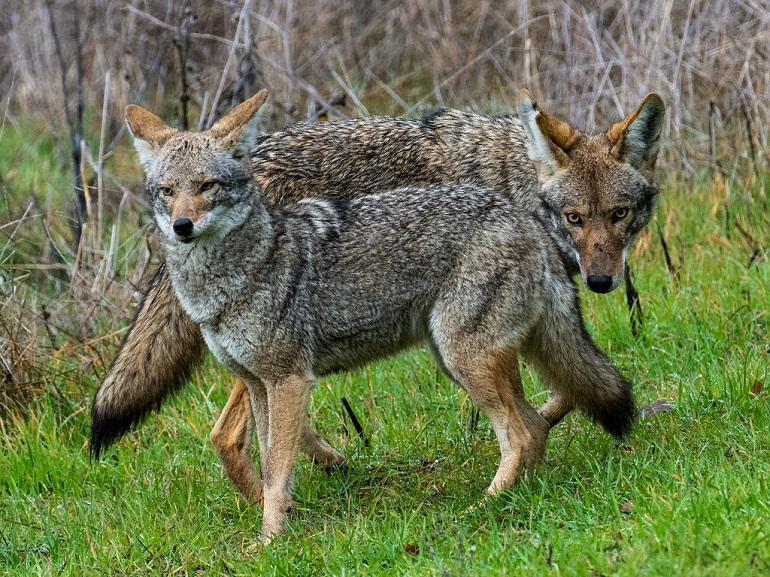
Social and Reproductive Behaviors
Brush wolves can be solitary or pack animals with close social bonds. They form packs with established dominance hierarchies, with the alpha pair at the top and the betas below them. These packs are typically small, consisting of a family of about five or six that defend their territories. If solitary, these may be beta males trying to form packs.
For clarity, brush wolves form family packs rather than large groups. Once the alpha female has her pups, the females remain with her and her partner, and the males leave when they’re old enough to survive alone.
Depending on food availability, family groups can grow to large numbers of 20 or more. The packs will be smaller when food is scarce, and high coyote densities prevail.
Unlike dogs that are fertile several times a year, female prairie wolves are fertile for about 60 days of the year. Because of this, the brush wolf breeding time requires a careful strategy. These animals are obligate monogamists because rearing the pups requires a breeding pair to share the responsibilities.
Another method is that females share dens to raise a larger litter with a better chance of survival due to more significant numbers. The beta members do not reproduce.
The alpha male and female pair up to reproduce and are genetically distinct from the rest of the pack, being closely related. Before the female coyote becomes ready for reproduction, an elaborate courtship is evident.
The pair becomes frisky, engaging in play that involves chasing, wrestling, bumping hips, and pushing against each other. For hygienic reasons, allogrooming is vital in interactions, displaying affection, and mutual cleaning.
Prairie wolf females enter estrus halfway through winter and mate around February. The gestation timeframe lasts for about 63 days. When ready to give birth, the female will dig a coyote den or find an existing shelter. While in this vulnerable state, the alpha male will hunt and feed his partner.
Their litters average five to six pups and higher. The pups are utterly dependent on their parents as they are deaf and blind at birth. Their eyes open after about 12 days, and both parents feed the pups, which can eat solid food after two or three weeks when they leave the den.
After four months, these coyote puppies are ready to join their parents in hunting for small meals.
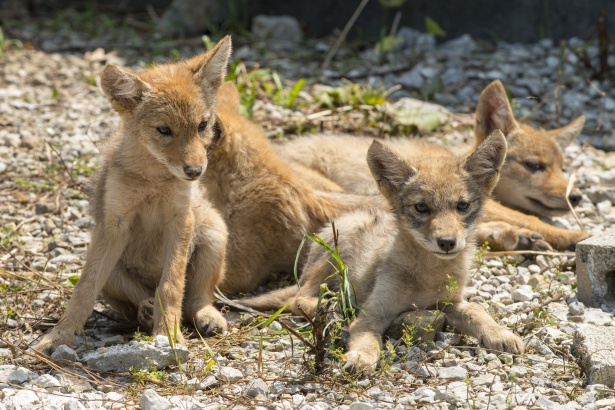
Territorial and Sheltering Behaviors
Coyotes are aggressive and defend their space from other packs during the mating season. Outside of the mating season, they are less aggressively territorial. However, these animals are also partially nomadic, so they will move around frequently within their territory. Their space can be less than a square mile to 24 miles.
When the female is ready to give birth, she will dig her own den or find existing burrows. Coyotes share den space with other animals like raccoons or badgers.
Once the shelter becomes too unsanitary, the parents move with their coyote pups to another refuge. If predators find the sanctuary, this will also motivate them to move. Coyotes ensure they have multiple dens for safety or to move to for hygiene reasons.
Because these animals only use dens when they have pups, they sleep in shelters like rocky outcrops. They will shelter in long grass and shrubbery or dig shallow holes to sleep in or to cool down. Essentially, they will sleep anywhere they feel safe.
Hunting and Feeding Behaviors
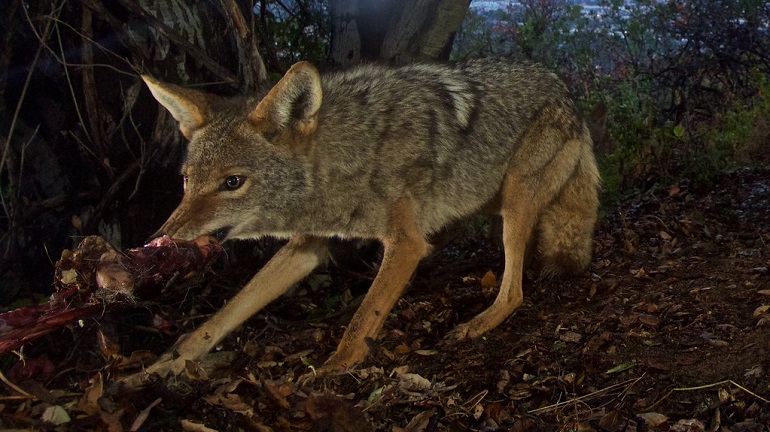
Coyotes have a reputation for being wily carnivorous hunters. Despite living in small family packs, they hunt alone or in pairs. If the prey in their region is primarily large, they hunt in packs to bring down these animals.
When hunting, they can cover up to ten miles daily if necessary in pursuit of their next meal. Young coyotes do not accompany experienced animals on hunts.
Because coyotes in the wild are diurnal, they hunt during the day. However, they are also good nocturnal hunters. Hunting at night is often safer in urban areas or where predation in the wild is high during the day.
These animals are recognizable for their coyote-pouncing behavior. When on a coyote hunt, they also stalk their prey and do a dash, bite, shake and kill action to immobilize their prey.
Coyotes sometimes will team up with badgers to dig up their quarry underground. Coyotes may also urinate on their prey on occasion after they have killed it, but not always. They mostly hunt by sight but also use their ears and sense of smell to locate their target.
Communication
Like wolves, coyotes have a range of vocalizations. They like howling, yipping, barking, whining, growling, and huffing through their noses. If you live in coyote territory, you may hear the sound of a barking dog at night, which is actually a coyote. When these animals bark, they give the impression that their numbers are far greater than reality.
Besides vocalizations, they use body language to send various messages. Urinating throughout their territory warns other coyotes to stay away. They also mark their range with scat to warn off other animals.
Coyotes’ vocalizations include warnings, aggression, anger, affection, and many others. Because domestic dogs and coyotes share a common ancestry, their communication behaviors are similar. So, when your dog makes certain sounds or behaves in a specific way, you can count on the fact that coyote conduct is the same or similar.
Coyote Habitat
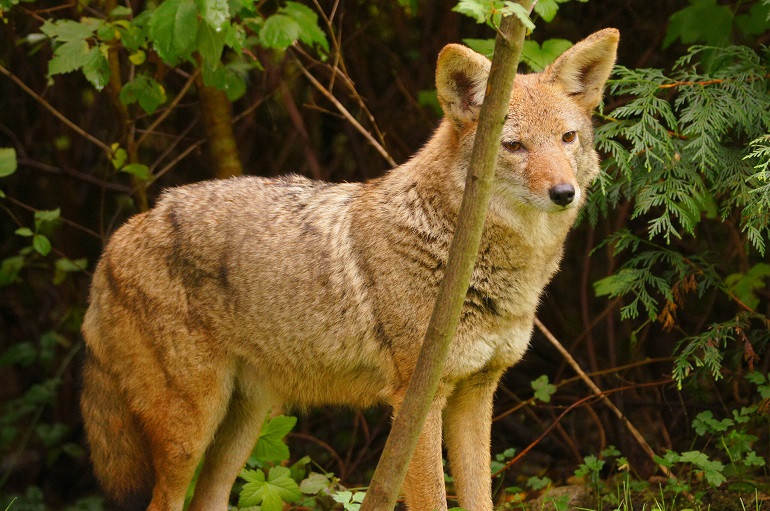
Coyotes typically live in the open plains or mountains, but these animals are adaptable. So they will live wherever they feel safe and can access enough food. Because wolf populations have declined, coyotes have expanded their population numbers and habitats.
They adapt to desert areas where they find food and shelter. If other packs occupy these regions, they will move to new territories like mountainous areas. If necessary, they will also migrate to wooded, urban, or suburban areas. When coyotes move into cities, you will see them sleeping on golf courses and in shrubbery near homes or parks.
In summer or winter, coyotes sleep in the open but often seek the protection of rocks, shrubs, or something to give them an edge if they are under attack. Wherever they live, they frequently dig a shallow hole to sleep in at night for extra comfort.
Species of Coyotes
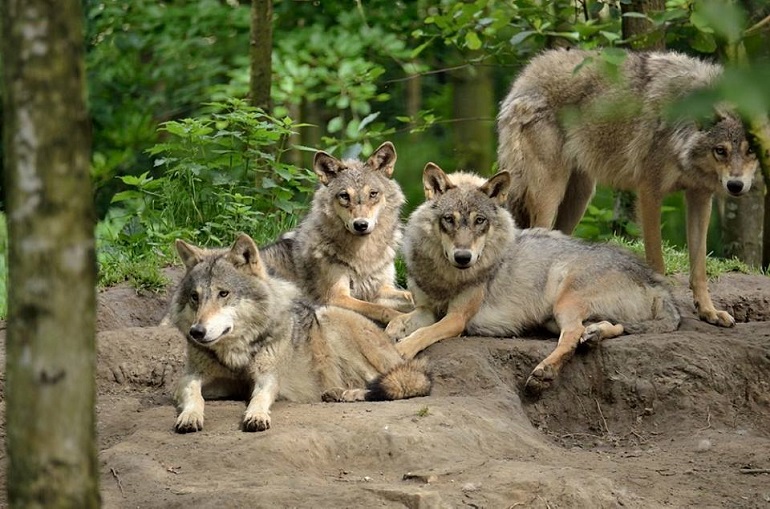
Scientists recognize 19 coyote subspecies at the moment. Most of these subspecies are identifiable by their habitats and geographical regions. Examples include the canis latrans microdon, northeast, and canis latrans peninsulae.
Some of these subspecies have evolved due to interbreeding with animal species like wolves. Other evolutionary causes include natural adaptations by moving to new territories.
The complete list of the 19 modern coyotes is the following:
- Belize coyote
- Durango coyote
- California Valley coyote
- Colima coyote
- Honduras coyote
- Lower Rio Grande coyote
- Mearns coyote
- Mexican coyote
- El Salvador coyote
- San Pedro Martir coyote
- Tiburón Island coyote
- Texas plains coyote
- Mountain coyote
- Peninsula coyote
- Plains coyote
- Southeastern coyote
- Northern coyote
- Northwest coast coyote
- Northeastern coyote
What Do Coyotes Eat?
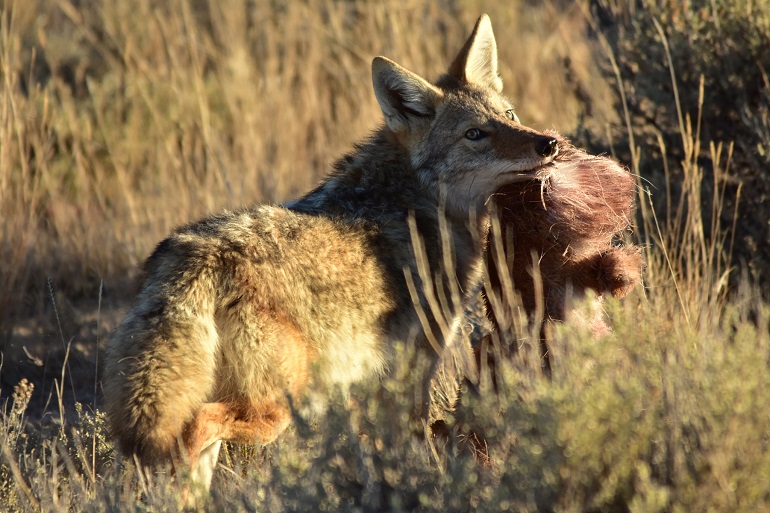
These animals are omnivorous, opportunistic eaters that like a varied diet. So, they eat the meat of other small game like rabbits and large deer. They also consume large quantities of vegetable matter.
Coyote populations hunt small prey like snakes, mice, rats, ground squirrels, and other small mammals in the wild. Other food sources are game species like geese. This brush wolf even feeds on insects.
If pressed, coyotes hunt larger animals, such as adult deer. Unsurprisingly, in most cases, the coyote cannot kill an adult deer alone. Still, they are perfectly capable when they work in packs.
Otherwise, they can also target farm animals if wild food supplies run low. When they live in urban areas, coyotes can hunt domestic animals. They will delve into trash cans to survive, but this conduct is rare since they prefer natural food.
Coyote Lifespan
Coyotes survive for ten to 14 years in the wild. Because they have no predators in captivity, they can live as long as 20 years.
Coyote Range
You will find coyotes almost everywhere across North and Central America. They spread across territories in New England and Canada. You also see this species in Alaska, although several subspecies of the coyote population enjoy warmer regions like Panama and Mexico.
Diseases and Parasites
Studies show that the coyote is the victim of most diseases and parasites among the larger carnivores in North America. Experts suspect that this infection rate results from their extensive range and diet. Besides, many of their prey carry diseases.
Coyotes often suffer from tularemia, a bacteria spread through infected ticks.
Among the viruses that infect coyotes are the following:
- Rabies
- Canine hepatitis
- Oral papillomatosis
- Equine encephalitis strains
- Canine distemper
Skin infections from mites and ticks can cause sarcoptic and demodectic mange. They are also susceptible to multiple fluke infections, including:
- Nanophyetus salmincola
- Trematode Metorchis conjunctus
- Tapeworms
- Roundworms
Several viruses and worm infections are dangerous and have high mortality rates.
Coyote Adaptations
The prairie wolf is so successful because it is adaptable. This adaptable nature has led it to interbreed with other species like red wolves and dogs. Over time, interbreeding or hybridization has produced various species. These hybrids are known as coydogs or coywolves, depending on the mix.
Coyotes are naturally diurnal or crepuscular, hunting during daylight or twilight hours. Due to other predators hunting them, they have adapted to hunt at night. This strategy helps them avoid predation and preserves their numbers.
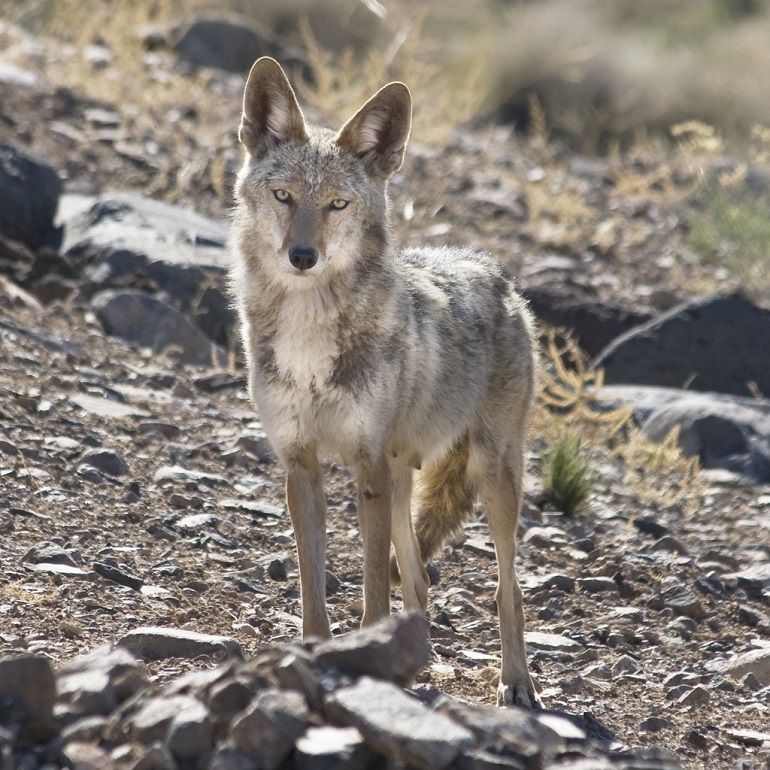
Their eyes have more rods than cones, allowing them to produce more rhodopsin pigment at night. This adaptation ensures that these predators can see better in low-light conditions. Add the tapetum lucidum under the retina, and they have excellent eyesight in low-light conditions.
Another example of the adaptations is their ability to live alongside humans. As people have encroached on their natural territories, they have learned to adapt their behavior and thrive.
These animals form packs in the cold months to improve their chances of hunting food and surviving. They can also regulate their body temperatures, ensuring they don’t overheat during hunts or have heart attacks due to intense exertion.
Coyotes adjust their litter sizes depending on the abundance of food and coyote numbers in a region.
Facts About Coyotes
There are some differences between the eastern coyote and their western counterparts.
Brush wolves or prairie wolves have reddish brown fur with silver and black. Those in the east tend to have more vibrant colors than those in the west. Most have a white underbelly and a bushy tail. Some prairie wolves are recognizable by a black-tipped tail.
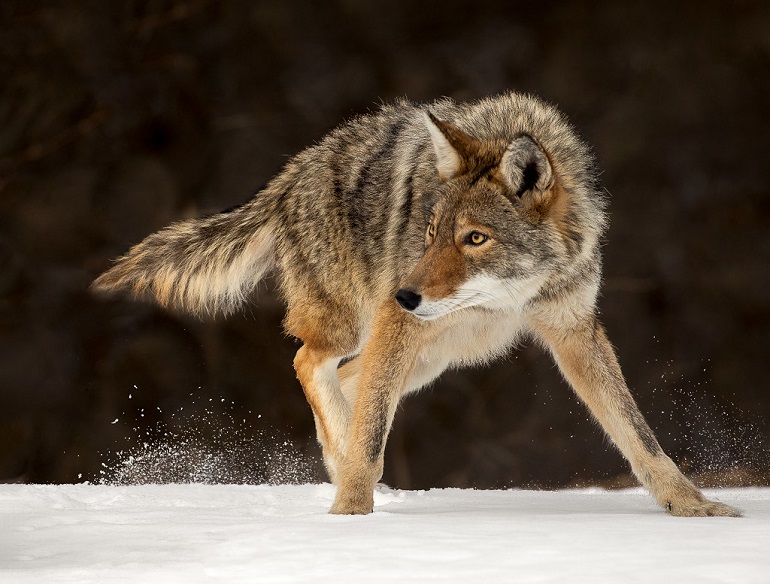
The eastern coyote is larger than the one in the west. It weighs more, has a larger head, longer legs, bigger teeth, and paws, and its tail is often longer and bushier. Most subspecies have large ears.
Weights differ, with animals in the east and northeast reaching 50 pounds while those in the west are slightly smaller, reaching an average of 30 pounds.
Enemies and Competitors
Coyotes face the most prominent threats from people and dwindling habitats jeopardizing food sources. Other than people, the biggest predators of these animals are the grizzlies and the American black bear. Cougars and the Canadian lynx also threaten their existence.
From the air, eagles are among other predators that threaten this animal. Strangely, a significant threat comes from the wolf. But as their territories decrease and hunting threatens the wolf’s numbers, this smaller relative gains the upper hand.
Conservation Status of Coyotes
The coyote is one of the most common species across Northern America. Western coyote numbers are stable from the Pacific Coast to Baja California. Likewise, their western counterparts are also safe from being extirpated.
Equally, the eastern coyotes are thriving. Because of this stability, they are of the least concern, according to the International Union for Conservation of Nature (IUCN).
How Can You Avoid Conflicts with Coyotes?
Biologists advise that treating them as wild animals is the most promising way to avoid conflicts. Instead of trying to domesticate them or treat them like dogs, people should stick to firm boundaries.
People may intentionally feed these animals or provide them with meals by leaving pet food outside. As tempting as it may be to feed them, this encourages a loss of fear.
Several studies show that coyotes naturally fear people. They can become aggressive and attack people and their pets when they lose this fear. This unfair conduct by people often leads to the coyote’s death as the animal threatens human health and wellbeing.
Relationship With Humans
Human-coyote relationships have been mixed. Some have been mutually respectful, while most have been exploitative at best. We examine some of these relationships in this section.
In Folklore and Mythology
First Nation People like those in California, the Plains, and those living in the southwest held the coyote in high regard. These people considered it the primary animal before humans lived on the earth.
Stories abound in the history of the brush wolf having many traits. It was seen as a good lover, creator, and magician. On the dark side, it was also known to be greedy and crafty.
Early people passed down tales of the coyote through verbal storytelling. According to these myths and folklore, the prairie wolf possessed its own independent creative energy force. It inspired artistic endeavors but was also at the center of poor decision-making on more than one occasion.
Additionally, myths tell of how this four-legged prairie wolf was the source of day and night, fire and light. This tricky creature was also the catalyst of chaos when crossing existing social boundaries.
Attacks on Humans
Coyote attacks on humans are so rare that there are only two documented cases on record. One documented case is of a child that was killed by coyotes in Southern California in the 1980s. Another case involves a young female teenager of 19 who encountered a coyote and was killed in Nova Scotia in 2009.
Livestock and Pet Predation
The eastern coyote has a far larger skull than its western counterpart. Livestock owners have noted this size difference, suspecting that it helps them kill their farm animals and hunting stock like small and large deer.
Because of this predatory pattern, they kill coyotes with poison and other means. Coyotes may also go after small pets, so it is best to keep them inside at night and not leave food out.
Hunting
Brush wolves are easy game for hunters all year round. They only need a special permit to hunt them if they want to sell their meat or fur. Hunters should check their State laws regarding the parameters of hunting this wild creature.
Fur Uses
The fur of this animal goes into the trim trade. Auctions are held across Canada for sales across this country, and the U.S. Clothing manufacturers use coyote fur to trim hoods and cuffs on parkas and other winter coats.
FAQ’s
How Big Can a Coyote Get?
Their length can range between 3.5 and 4.5 feet from head to tail. It can weigh between 25 and 50 pounds. In contrast, the wolf grows to lengths of 5 to 6 feet and can weigh anything from 50 to 100 pounds.
Where Do Coyotes Live?
Coyotes occupy vast areas across Northern America, including the U.S., Canada, and Alaska. Due to dwindling territories, this animal continues to expand its range southwards, living in Mexico, Panama, and Belize.
It continues to expand its territory, moving toward South America. The one U.S. state it does not yet occupy is Hawaii. As noted earlier, people have introduced this animal into Europe.
Regarding habitat, they live in grasslands, prairies, deserts, wetlands, forests, and urban and suburban areas. They even live along coastlines.
Coyote, Wolf, or Dog?
The Coyote belongs to the Canis latrans species. Although this predator contains genes from the red wolf, the modern wolf is a part of the Canis lupus species. The domestic dog also descends from the wolf but belongs to the C. familiaris species.
While all these animals share traits, they differ slightly in their genetic makeup and, therefore, their taxonomy.
Conclusion
We have given you a comprehensive overview of coyote populations. Their lives are as diverse as their personalities. The history of these animals has also been challenging.
But their will to live has won out against all the odds, like encroaching civilization, hunting, culling, and poisoning. Ultimately, the coyote has thrived because they are adaptable.


